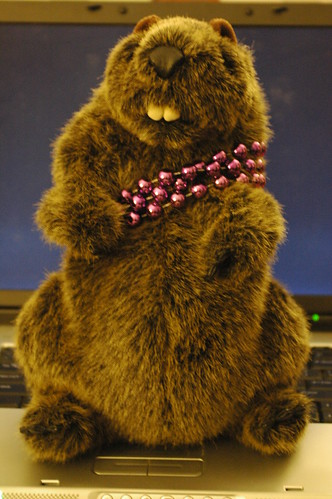 Happy Imbolog to all my fellow gardeners!
Happy Imbolog to all my fellow gardeners!
Groundhog Day, celebrated on February 2, has its roots in an ancient Celtic celebration called Imbolog [Wikipedia: Imbolc]. The date is one of the four cross-quarter days of the year, the midpoints between the spring and fall equinoxes and the summer and winter solstice.
– NOBLE Web: Groundhog Day
The groundhog, Marmota monax, also known as a woodchuck, or whistlepig, is the largest species of marmot in the world.
Imbolog, marking the midpoint between the winter solstice and the spring equinox, was the most important of the cross-quarter days. In a society dependent on agriculture and therefore on the weather, this was a time to celebrate having made it halfway through winter. The superstition arose that if the weather was fair on Imbolog, the second half of the winterwould be cold and stormy, but if the weather was cold and overcast or stormy, the second half of the winter would be mild.
In early Christian times, February 2 was celebrated as Candlemas, but the earlier Imbolog superstitions persisted. In medieval Scotland, for example, they said, “If Candlemas be bright and clear, there’ll be two winters in the year” and in England, they said, “If Candlemas be sunny and warm, ye may mend your mittens and look for a storm.”
The Romans learned these traditional beliefs from the Scottish Celts, and brought them to the area that was to become Germany, where they became a part of the folk culture. German immigrants brought these beliefs with them to Pennsylvania, where the tradition of predicting the weather became centered around the woodchuck or groundhog. The town of Punxsutawney, Pennsylvania, has an annual celebration centering around the activity of the groundhog “Punxsutawney Phil.”
– NOBLE Web: Groundhog Day, via Librarians’ Internet Index

Thanks, Xris Gardener, for visiting my blog! Hope you’ve liked what you saw!
I dream of integrating bushes (topiary)in a wire sculpture for outdoors. May be you could help me bring this idea a little further.
http://lingni-net.blogspot.com/
Happy Imbolc! As for that groundhog – personally, I’m rootin’ for shadow 😉
Interesting! I had never heard of Imbolc. Here the news shows tell us that German immigrants brought along the custom of waking up a poor hibernating animal… no mention of ancient Celtic festivals. It amazes me how much those old traditions were all mixed up and put together. I must investigate further..